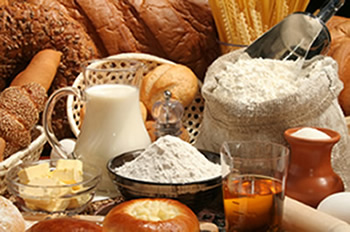 |
| Borrowed from Google Images |
Flour:
You can use any kind of flour with gluten for my recipe. Strong white, strong wholemeal, granary, other grain mixes, even ordinary not-strong flour although the texture will be different. You can get bread flour in just about any supermarket or you can buy it online from specialist suppliers (at a premium price, unfortunately). If you have a working mill near you, you're lucky! I haven't tried using any Rye flour but a little bit might be OK. I must try it sometime.
I mix my flours. The dough that is currently proving as I type is a mix of a grain flour, wholemeal and white. As long as the total weight is right, it doesn't matter. What changes is the amount of water you use (see below).
When I did Live Below The Line I used value plain white flour and you know what? The loaf it produced was very acceptable although I kneaded it for longer to give the gluten a chance to develop.. Rather a soft crumb, especially first day, but it toasted well, made perfectly good sarnies and was dead cheap as well as tasty! Oh, and it froze well. Well under 10p for a 1lb loaf. That's frugal!!!
Yeast:
Well, what can I say? Bakers argue over yeast. There are three main kinds unless you venture into the realms of sourdough. There's fresh yeast, there's dried active yeast and there's easy bake yeast. Fresh yeast is lovely but not always that easy to get hold of and to keep and I don't use it that much. Dried active yeast works well but needs to be 'started off' with warm water and sugar. Easy bake yeast is the sort that you need for breadmakers and it's so easy to use. I have both kinds of dried yeast in my fridge but tend to use the easy bake although I LOVE to see the other activating and frothing up. It is magic!
Oil:
I use what comes to hand. Veg oil is cheaper. Olive oil imparts a lovely flavour and if you're making a flavoured bread it is great. Sometimes I use a dollop of butter instead. I suppose about a tbsp per loaf is about right but I rarely measure.
Salt and sugar:
Whatever. No need to go fancy unless you want to! My recipe uses ordinary salt and granulated sugar.
Water:
Ah - water. An important one. No, not because I am advocating fancy bottled water* or sparkling water. It's not what, it is how much. You see, what flour you use determines how much water you use. It is all based on percentage and is a lot simpler than you would think so please, bear with me.
(* however, if you have very strongly chlorinated water, you might want to consider bottled water - at 18p a bottle from Morrison's, it's not going to break the bank)
An all white loaf needs 63% water to flour
An all wholemeal needs 70% water to flour
Mixes are somewhere in between - I tend to work on around 67%
I round all amounts to the nearest 5g
Each time I make bread I work it out and this is what I do.
I keep a little 75p (from Morrisons) calculator in the kitchen. I input the weight of flour, divide it by 100 (to get 1%) and then multiply it by the percentage of water.
So -
Water for a single 1lb white loaf would be 200 (the weight of the flour) divided by 100 (to get 1%), multiplied by 63 which comes to 126 so I add 125g (or mls - same thing) of water
Water for a single 1lb wholemeal loaf is 200 divided by 100 multiply by 70 which is 140 so I add 140g (or mls) of water.
And so on . . .
The other question is temperature. If I'm in a hurry I use warm water. If I'm not I use cold. The latter creates a slower rise but slower is better in taste terms.
Part 1: introduction
Part 3: equipment
Part 4: my recipe
From my bakers book I like the phrase "wetter is better" where bread is concerned
ReplyDeleteSends shudders down my spine. :-) But yes!
ReplyDeleteJ x